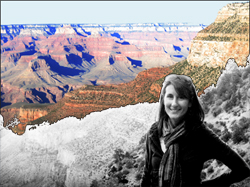 Felicia checks out the actual topography of the Grand Canyon.
Felicia checks out the actual topography of the Grand Canyon.
• Energy in the Earth System
• Ecology
 Felicia checks out the actual topography of the Grand Canyon.
Felicia checks out the actual topography of the Grand Canyon.
Students imagine themselves located at multiple seismic stations that encircle the Earth. Each student receives a unique seismogram for an earthquake that has taken place somewhere in the world. Their collective task is to determine the general location of the earthquake based on seismic wave arrival times.
Number of students: Up to 36 students working in groups of three.
Time - TBA.
Wallspace - place to post 3' x 3' wall chart of cutaway Earth
Computers - one per 2-3 students.
Green - Activity can be paperless, although materials for print are provided.
Online - Most of this activity is available online, including automated feedback for the learner.
Math - Activity requires applied arithmetic
Analytical reasoning - Activity requires data analysis and quality control judgment.
Collaboration - Activity requires analysis of data collected by others
| Clue 1 - Plate tectonics | |
| |
| Tab 2 |
| Tab 3 |
| Tab 4 |
| This activity was produced by Earthguide, the Center for Ocean Sciences Education Excellence (COSEE) - California, and the Enhancing Science Education Through Technology (ESETT) program at the EdTech Department at San Diego Unified School District (SDUSD). Teacher - Felicia Ryder, Wangenheim Beach Middle School, San Diego Unified School District. Educator/web developer - Memorie Yasuda at Earthguide, Geosciences Research Division, Scripps Institution of Oceanography. Educational technologies resource teacher - Mike Senise at ESETT, San Diego Unified School District. Scientist - Dr. Cheryl Peach at COSEE and Scripps Institution of Oceanography. |